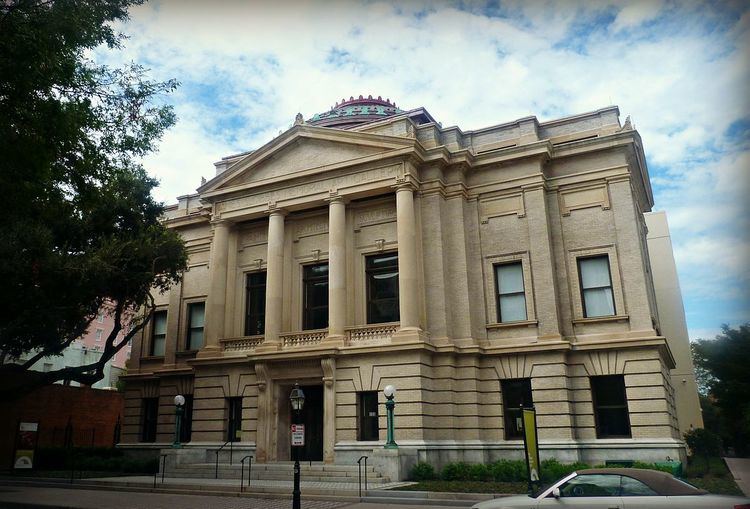Established 1905 Curator Sara Arnold, Pam Wall Phone +1 843-722-2706 | Director Angela Mack Website gibbesmuseum.org Founded 1905 | |
 | ||
Location 135 Meeting StreetCharleston, South Carolina Hours Closed today MondayClosedTuesday10AM–5PMWednesday10AM–8PMThursday10AM–5PMFriday10AM–5PMSaturday10AM–5PMSunday1–5PM Artwork Thomas Middleton of The Oa, Saint Philips - Charleston, General John R Fenwick, Cymon and Iphigenia, April : (The Green Gown) Similar Charleston Museum, Confederate Museum, Nathaniel Russell House, Middleton Place, Charles Towne Landing Profiles | ||
Traveler s notebook charleston edition visiting the gibbes museum of art
Formerly known as the Gibbes Art Gallery, the Gibbes Museum of Art is an art museum in Charleston, South Carolina. Established as the Carolina Art Association in 1858, the museum moved into a new Beaux Arts building at 135 Meeting Street, in the Charleston Historic District, in 1905. The Gibbes houses a premier collection of over 10,000 works of fine art, principally American works, many with a connection to Charleston or the South.
Contents
- Traveler s notebook charleston edition visiting the gibbes museum of art
- Gibbes museum of art 3 8 16
- References
The benefactor, James Shoolbred Gibbes, donated $100,000 to the Carolina Arts Association upon his death in 1899 for the "erection of a suitable building for the exhibitions of paintings." Receipt of the money by the city, however, was delayed by a will contest filed by nieces and nephews of Gibbes. Their case was heard in the state court of New York during 1900 and 1901. On December 6, 1901, the New York Supreme Court (the state's trial-level court) issued an opinion declaring that the gift to Charleston was valid.
Receiving the money in 1903, the Association hired Frank Pierce Milburn to design the gallery. His design included a Tiffany-style dome, Doric columns and pediment capped windows and doors. Milburn completed the drawings of the building in mid-1903, and a drawing of the proposed building appeared in the Charleston Evening Post on June 5, 1903. Notices were published seeking contractors' bids for the work starting in August 1903. In September 1903, H.T. Zacharias was selected as the contractor and received a contract for $73,370 for the building. Zacharias started work on September 28, 1903, removing the remains of the South Carolina Agricultural Hall which had occupied the lot. Although work on the foundations had begun already, a ceremony was held on December 8, 1903, to lay the cornerstone of the building at the northeast corner.
The museum formally opened on April 11, 1905. The collection on display on the opening day included more than 300 pictures, many bronzes, and about 200 miniatures in addition to an "instructive collection" of Japanese prints.
After closing for an extensive two-year, $13.5 million renovation, the museum reopened to the public on May 28, 2016. In renovating the museum, the development teams took inspiration from the original blueprints discovered in the City of Charleston archives in 2008 to return the building to its 1905 Beaux Arts style layout. The renovation of the first floor features a creative education center that engages the public through classrooms, artist studios, lecture and event spaces, a café and a museum store. The rear reception area opens to the garden, part of Charleston’s historic Gateway Walk founded by the Garden Club of Charleston. Serving as a creative gathering place for the community, the entire ground floor of the museum is admission-free.
The newly expanded and renovated galleries on the second and third floors provide a 30 percent increase in gallery space to showcase more than 600 works of art from the permanent collection. State-of-the-art storage facilities feature a closely connected research room to provide ample space for scholars to more easily access and study works from the collection. Observation windows offer visitors a behind-the-scenes view of the work of curators and conservators. The Gibbes’ renowned collection of more than 300 miniature portraits are housed in innovative display cases and open storage cabinetry to allow an up-close view for visitors.
The museum's collections include the work of numerous artists with connections to Charleston; among them are Henrietta Johnston, Mary Roberts, Charles Fraser, William Melton Halsey, and Jeremiah Theus.
